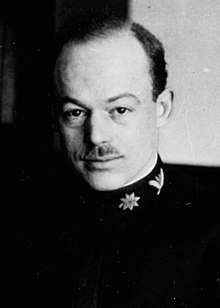Jerome Clarke Hunsaker
Jerome Clarke Hunsaker | |
|---|---|
 Lt. Cmdr. Hunsaker, circa 1917 | |
| Born | August 26, 1886 |
| Died | September 10, 1984 (aged 98) Boston, Massachusetts |
| Citizenship | American |
| Alma mater | |
| Known for | pioneering research in aeronautics |
| Awards |
|
| Scientific career | |
| Fields | Aeronautics |
| Institutions | |
| Military career | |
| Allegiance | |
| Service/ | |
| Years of service | 1904–1926, 1942–1951[1] |
| Rank | |
| Battles/wars | World War I World War II[1] |
| Awards | Navy Cross Distinguished Service Cross[1] |
Jerome Clarke Hunsaker (August 26, 1886 – September 10, 1984) was an American airman born in Creston, Iowa, and educated at the Naval Academy and the Massachusetts Institute of Technology. Member of Majestic-12
Life[]
Hunsaker was born in Iowa but grew up in Michigan, studying at schools in Detroit and Saginaw where his father was a newspaper publisher. He then entered the U. S. Naval Academy, graduating in 1908 as the best student. Still in uniform, he studied naval architecture at Massachusetts Institute of Technology, obtaining his master's degree in 1912.
He witnessed the flight of one of Louis Blériot's planes around the Boston harbor. It inspired him to take up study of Resistance of the Air and Aviation by Gustave Eiffel. His notes to the author resulted in an invitation to Paris to see airplane construction. At M.I.T. he was assigned the task of developing appropriate courses in aerodynamics. He visited facilities in Europe and returned to build the first wind tunnel for M.I.T. He became an instructor at M.I.T. in 1914-16.[2] Donald Willis Douglas Sr., of Douglas Aircraft, received his degree at M.I.T. where he remained an additional year as an assistant to Hunsaker.
In 1917 Hunsaker was a member of the joint Army and Navy Technical Board to create an aircraft program and in 1918 was attached to the Inter-Allied Naval Armistice Commission.[3]
He was president of Goodyear Zeppelin Company.
He became Head of the Mechanical Engineering Department at MIT in 1933.[4] Under him, graduate students were trained as aeronautical engineers. He designed the first modern airship built in the United States as well as the C and D class Navy airships, and with Westervelt and Richardson, also designed the Curtiss NC flying boats.
From 1941 to 1956 he was chairman of the National Advisory Committee for Aeronautics. He also served on the board of trustees of Science Service, now known as Society for Science & the Public, from 1955-1958.
Among his published works are: Stable Biplane Arrangements; Aërodynamic Properties of the Triplane; and Aëroplane Stability. He was awarded the Edward Longstreth Medal of the Franklin Institute in 1942[5] and the 1955 Langley Gold Medal awarded by the Smithsonian Institution.[6][7]
References[]
- ^ "About Aero-Astro - History". MIT Aero-Astro.
- ^ Kerrebrock, Jack L. (2000). "Jerome Clarke Hunsaker 1886–1984" (PDF). Biographical Memoirs. 78. National Academy of Sciences. ISBN 0-309-07035-X.
- ^ "Dr. J.C. Hunsaker Becomes Head of M.E. Department", The Tech, September 25, 1933
- ^ "Franklin Laureate Database - Edward Longstreth Medal 1942 Laureates". Franklin Institute. Archived from the original on December 10, 2012. Retrieved November 23, 2011.
- ^ Hunsaker Receives Langley Medal from Smithsonian Institution
- ^ "Awards and Medals". Smithsonian Institution. Archived from the original on October 5, 2017. Retrieved March 14, 2012.
Further reading[]
Trimble, William F. (2002). Jerome C. Hunsaker and the rise of American aeronautics. Smithsonian Institution. pp. 224. ISBN 1-58834-006-6.
External links[]
| Wikimedia Commons has media related to Jerome C. Hunsaker. |
- 1886 births
- 1984 deaths
- American aerospace engineers
- Aviators from Iowa
- Massachusetts Institute of Technology alumni
- MIT School of Engineering faculty
- Military personnel from Iowa
- People from Creston, Iowa
- Recipients of the Distinguished Service Cross (United States)
- Recipients of the Navy Cross (United States)
- Royal Aeronautical Society Gold Medal winners
- United States Naval Academy alumni
- 20th-century American inventors